Marvel vs. Capcom Infinite makes big changes in the name of accessibility
For better or for worse?
Having played Marvel vs. Capcom Infinite for a few hours, I know this much: it'll be a divisive fighting game.
Capcom has made interesting changes in the name of accessibility - that dirty word - and I'm sure they'll set alarm bells ringing among the fighting game community.
The thing is, a lot of the changes make sense to me, even as someone who loves the chaotic combos of Capcom's vs. series. And in any case, the issue of accessibility is something of a red herring. The key question is whether MvCI retains the depth fighting game fans demand, even as it provides an easy in for newcomers. It is this question MvCI must answer convincingly in order for it to be considered a success.
So, what's changed in the name of... spit!... accessibility? Let's start with the button layout, which is significantly different from previous games. MvCI uses a six button layout: light punch and heavy punch, light kick and heavy kick, an infinity stone button and a switch button.
MvC3 also used a six button layout but the buttons did different things. It had buttons for light, medium and heavy attacks, an air combo button, assist partner A and assist partner B. The idea here is MvCI is better suited to a pad, which Capcom reckons the majority of players will use to play. Many hardcore fighting game fans use a stick, and Capcom wants to get away from the feeling that you need a stick to play well.
In keeping with the more accessible nature of the game, Capcom has added an incredibly simple way for your character to automatically perform a ground to air combo (if you're into your fighting games you might want to look away now).
You can mash light punch to do a ground combo that leads into an air combo - and if you keep mashing light punch you'll do an air combo that slams your enemy into the ground. Simply by mashing light punch, you can trigger an eight-hit or so combo that in previous games would have taken at least a few different button presses, a press of the air combo button, a button press to chase your opponent into the air and a few more presses of different buttons for an air combo. Now, you literally mash light punch and the game takes care of the rest.
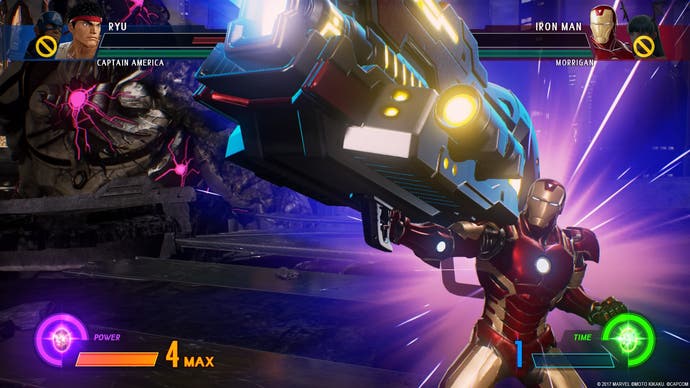
There's more. MvCI has a universal combo string designed to offer newcomers an easy entry into the world of manual input commands. Pressing light punch, light kick, heavy kick and then down heavy punch does a ground combo that launches your opponent into the air. The idea is that you roll your thumb around the face buttons of the console controller. It's a diamond shape across the pad that newcomers can rely upon because it works for all the characters.
Now for hyper combos. In MvC3 to do a hyper combo you would, typically, have to do a traditional fighting game motion such as a fireball or a dragon punch and press a couple of buttons. In MvCI all you have to do to trigger your level one hyper combo is press two buttons: heavy punch and heavy kick. There's no motion input to consider at all.
As you may have already noticed, there's now one button for character switching. In MvC3 there were two, one for each of your two partners, and you could choose to trigger an assist, which would have a different effect depending on the character, or just simply call them in. MvCI is a 2v2 game, so you only need one button for switching. Although it seems simple, you can switch anytime and anywhere while doing anything.
In previous games there were a lot of rules that governed when you could tag and what your character would do when they came in. For MvCI, Capcom has stripped away these rules. If you're jumping around you can bring in your partner. If you're performing a combo, you can have your partner come in and keep transitioning between them. If you do a hyper combo you can switch out of it, running behind the projectile. In short, you can use switch in offense and in neutral in a way you couldn't in previous games in the series.
It's worth noting how to use switch as a defensive move, too. The aerial counter system of MvC3 has been ditched in favour of an easier to trigger Counter Switch mechanic that involves simply pressing and holding the switch button. This burns two bars of your hyper meter, so you can't break combos all of the time. Press and hold the switch button and you're partner will rush onto the screen. You then switch control to the new character, allowing you to interrupt the beatdown your other character is suffering with an attack. In previous MvC games, if you were put in a combo, you pretty much had to watch and wait in the hope your opponent dropped it. Now, you can choose to try to interrupt the combo.
Combining these new accessibility mechanics, I was able to land combos in the high 20 hits range with just two buttons. Mash light for a ground combo that transitions into an air combo, keep on mashing to slam them into the ground, press the switch button to bring in your partner then mash light punch to repeat. I was able to perform this loop three times, ending with an easy hyper combo with the press of hard punch and hard kick. I didn't need to touch the thumb stick at all throughout.
The hardcore will no doubt turn its collective nose up at such mechanics, but it's easy to understand why they exist. MvCI comes out at a very different time for the Marvel brand than previous games in the series did. MvC3 came out before the first Avengers movie. MvCI comes out after the 16th Marvel movie. Times have changed.
"We've always had an amazing fighting game over the past 20 years, but it's been very light on story," producer Mike Evans tells me. "For the first time now we're going to tell this story, explaining how the worlds came together.
"We're trying to push it away from its predecessors. We're keeping the DNA of the vs. series, like the air combos, but at the same time creating something unique and original. Visually, we've moved to Unreal Engine 4. We've got a more cinematic direction with the visuals. You look at it and you immediately know it's a completely new game separate from the previous.
"MvC2 had this 2D style, which was cool. MvC3 went to 3D and had a toon-shaded style, which completely separated it from the previous predecessors. This time, we still have over-the-top effects, but we're pushing the graphics to make them feel modern and cinematic.
"For all those reasons, we decided to call it Marvel vs.Capcom Infinite instead of 4. 4 sounds like just an extension of 3."
You can see what Capcom's getting at here. It hopes a huge number of non-fighting game fans will play MvCI, perhaps for the story alone, so the game needs to look after them. That explains the new art style and that explains the new accessibility mechanics. Everything from the one-button combo to the easy level one hyper combo is designed to make newcomers feel like they can do something cool in a fight without having to put much effort in. But does this new "easy in" mean Marvel is all of a sudden a fighting game for casuals?
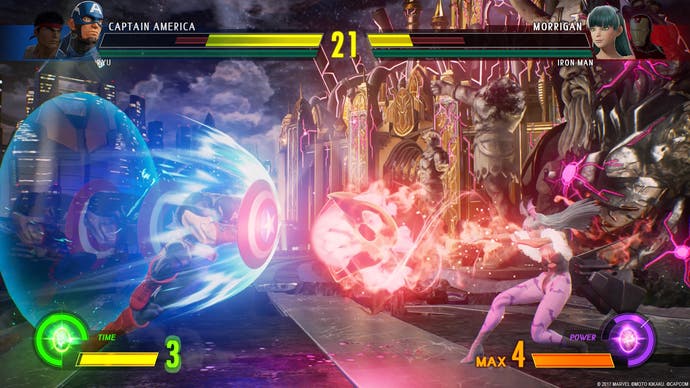
MvCI is a 2v2 game, down from 3v3 in MvC3. This means you only have to manage two characters, which on the face of it is an easier thing to do. But Capcom has added a third factor into the mix called Infinity Stones.
Marvel fans will of course know these Infinity Stones well. They grant the user immense power over a single aspect of reality. Capcom has announced three so far for MvCI: power, time and space. There will be six in the game at launch.
Before a match begins, you pick an Infinity Stone to use, and it's assigned to a single button - L1 on the PS4. So yes, MvCI has a stone button!
A press of the stone button triggers the Infinity Surge. If you have the time stone equipped, your character dashes left or right. If you have the power stone equipped, you hit your opponent for a wall bounce. If you have the space stone equipped, you can pull your enemy towards you.
When you've filled your stone meter up enough you can trigger the Infinity Storm (L1+R1). This activates the stone's super power. The space stone, for example, forces your opponent's character into a box, preventing them from moving around the screen. The power stone gives your character a huge damage boost. And the time stone makes your character much faster.
The stone button enables some interesting strategies that gets to the heart of Capcom's argument that MvCI has the depth the hardcore fighting games are after. The feeling at Capcom is the third character pick in MvC3 was essentially reduced to a functionality, rather than being a character people liked. The Infinity Stones, Capcom believes, can satisfy that functionality and more.
Peter "ComboFiend" Rosas, ex-tournament player and associate producer of the game, gives me an example of how this can work in a match.
"Let's say I'm playing as Chris Redfield and Hawkeye with the space stone," Rosas says, "and let's just say I want to have a more offensive feel to it. I make static traps more dynamic by pulling you with the stone. I'm developing this different strategy.
"Then I use a time stone and let's say I just want to run away and play this run and gun game, so I'm shooting from a distance, using all my projectiles and the second my opponent gets close to me I use the time stone to get away.
"Let's say you use the space stone to pull your opponent under you, then you call your partner in. Suddenly it's a crossup.
"It's the same two characters, but now they're playing differently, with just the application of a stone.
"There's a lot of depth there because there are decisions to be made and the battle system is so open. And it's pretty easy to understand, but at the same time, it's actually pretty deep once you get into it."
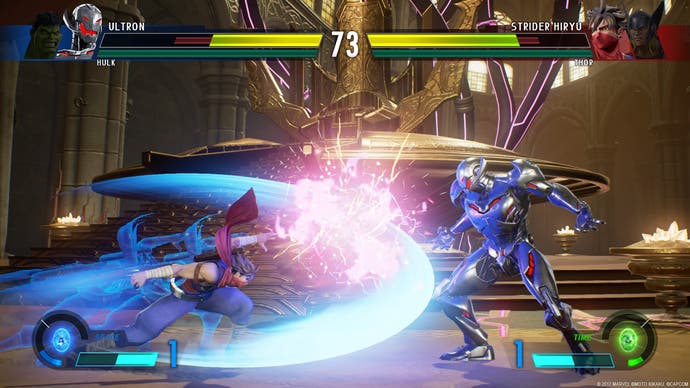
Making fighting games accessible without dumbing them down is a difficult thing to do. Capcom runs the risk of alienating the fighting game community as it tries to expand the audience for the genre. We've seen NetherRealm Studio achieve huge success with the Injustice series, which fuses Mortal Kombat-style gameplay with DC superheroes and villains. With Marvel being the behemoth it is, Capcom no doubt saw an opportunity to emulate its competitor's success.
I don't blame Capcom for trying, and I commend the company for doing more than it's ever done to make fighting games accessible. But I can't shake the feeling that MvCI loses something in the process. I'm not entirely sure what, yet - I need more time with the game to put my finger on it - but I'm sure the fighting game community will have some ideas.
What kind of reaction does Capcom expect from the fighting game community, I wonder?
"Unfortunately there seems to be this mindset that you sacrifice depth for accessibility," Rosas says. "But that's actually not the case here. Not in any capacity, really.
"What you have are simple commands that allow players access to their characters quickly. It allows them to get a good feel for the game quickly. Ideally that would lead to them wanting to explore the characters further, sticking around and essentially becoming a player."
So what's to stop every player simply relying on this light punch combo or this two-button hyper combo, reducing MvCI to some braindead button masher?
"Using these simple commands yields the same results every time," Rosas counters. "You always perform the same combo and it yields the same damage. When you use a simple hyper, you only have access to one hyper combo - one of many your character has. So, you do gain access to your character but not the deepest depths of them.
"For the more hardcore players who plan to put in time and effort, they'll have deeper access to their character. They will be able to do stuff that a person who hasn't put the time in will be able to do. There's really no real sacrifice being made there on their behalf."
"However, taking a step back, for those who haven't played a fighting game, if they just want to press the stone button, or press the switch button, push the attack buttons with their characters and see some cool things and do some damage, they can.
"Nobody's being left out in the cold here. Nothing is being sacrificed for either party. We're just making sure players who are unfamiliar are able to jump in and experience the world of Marvel vs. Capcom Infinite."

MvCI doesn't just follow MvC3, it follows Street Fighter 5 and its disastrous launch. Street Fighter 5 launched with server problems, no story mode and, perhaps worst of all, no arcade mode. It didn't go down well. MvCI launches with a cinematic story mode and an arcade mode. It's clear the powers that be at Capcom took note.
"There were learnings," Evans says. "What we noticed from Street Fighter 5 is obviously on day one we need to have a fully featured game. We need to have a story mode. It's more important even for this Marvel title than for Street Fighter 5 because you have all these new people who may come in just for the story mode.
"We've taken our time with this one and we're not going to release it until it's ready. We've been working hard on the story mode and also on arcade mode. The amount of content that's expected from fans for competitive titles these days, we've taken a note of that."
Street Fighter 5 came out on PS4 and PC only - there was no Xbox One version - and it featured cross-platform play. To facilitate this, Capcom created the Capcom Fighters Network, an infrastructure that layers on top of PSN and Xbox Live. It is much-maligned.
MvCI is set for PS4, PC and Xbox One, does not feature cross-platform play and does not use a separate online infrastructure. "There was a decision made at the beginning for Marvel," Evans says.
"When it comes to cross-platform play, when we did the postmortem on 5, it has its strengths but also its weaknesses. We still think it's a good fit for 5. But with this title, which is a less competitive crowd than Street Fighter, and we're trying to reach a broader fanbase, the cross-platform play doesn't come into the equation. It's more about just having a great online experience."
It's fair to say Capcom's Marvel games have become more complex over the years. To most people MvC3 is a nonsensical flurry or fast-moving characters and incomprehensible combos. Even if brand Marvel hadn't blown up, even if Capcom had gone for a MvC4 rather than a soft reboot, it was probably time to calm things down a bit.
The question for the fighting game community is, has Capcom done so for better or for worse?
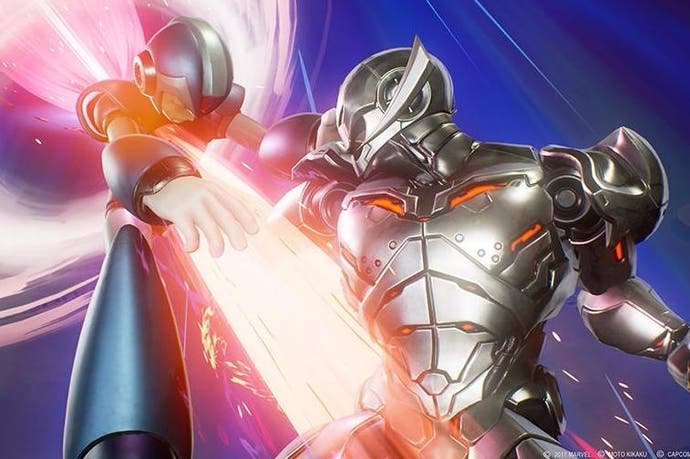


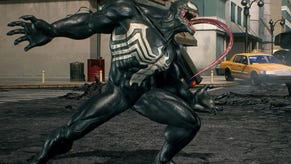
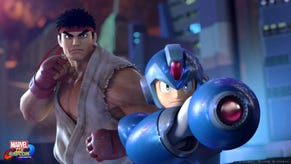
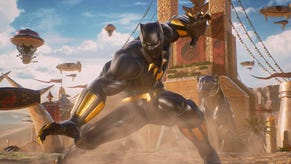

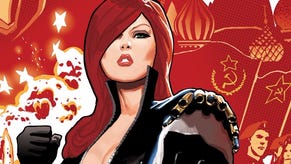
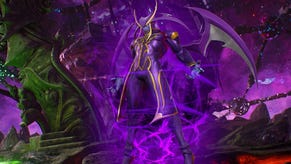
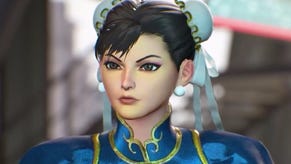


.png?width=291&height=164&fit=crop&quality=80&format=jpg&auto=webp)




.jpg?width=291&height=164&fit=crop&quality=80&format=jpg&auto=webp)
